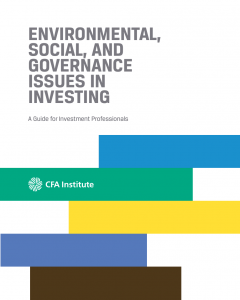Abstract
The practice of considering environmental, social, and governance (ESG) issues in investing has evolved significantly from its origins in the exclusionary screening of listed equities on the basis of moral values. A variety of methods are now being used by both value-motivated and values-motivated investors in considering ESG issues across asset classes. There is, however, a lingering misperception that the body of empirical evidence shows that ESG considerations adversely affect financial performance. For investment professionals, a key idea in the discussion of ESG issues is that systematically considering ESG issues will likely lead to more complete investment analyses and better-informed investment decisions.
Summary
A critical factor in the financial performance of investments is the investor’s ability to identify drivers of the expected risk and return of investments. Financial analysts and portfolio managers are expected to be familiar with the financial factors that drive the value of an investment. However, issues that are difficult to measure in monetary terms and that do not form part of traditional financial metrics also affect the risk and return of investments—at times, decisively. In general, these issues are referred to as environmental, social, and governance (ESG) issues.
ESG issues are often highlighted by news media when investors suffer sudden and substantial losses on listed equities—losses that are attributed to poor management of risks posed by one or more of these ESG issues.
There is no one exhaustive list of ESG issues. ESG issues are often interlinked, and it can be challenging to classify an ESG issue as only an environmental, social, or governance issue. These ESG issues can often be measured (e.g., the employee turnover at a company), but it can be difficult to assign them a monetary value (e.g., the cost of employee turnover at a company).
Although ESG issues frequently receive attention owing to extreme events that cause sharp drops in the stock prices of relatively large listed companies, they are not confined to equities, extreme events, or large companies. The ESG issues and related megatrends, such as scarcity of a natural resource (e.g., potable water) and changing demographics (e.g., the economic rise of pro-sustainability millennials), are relevant to investment risk and return across asset classes.
Most of the discourse on ESG issues has been focused on listed equities, but the practice of considering ESG issues with respect to other asset classes—most notably, fixed income—is growing.
Investors use six methods for bringing ESG considerations into their decision making: exclusionary screening, best-in-class selection, thematic investing, active ownership, impact investing, and ESG integration. These methods are not mutually exclusive and are often used in combinations.
A range of topics—including fiduciary duty, externalities, and disclosure—features prominently in the discourse on ESG issues in investing.
Both value-motivated and values-motivated investors consider ESG issues in investment decisions. There are some lingering myths about ESG considerations—most importantly, that ESG methods are confined to exclusionary screening and necessarily have an adverse effect on financial performance.
Important challenges face the evolving practice of considering ESG issues in investing. An obvious and structural challenge, which is not unique to ESG considerations, is short-termism in financial markets. But there are others. For instance, the case for “what” and “why” to consider ESG issues has been made with sufficient clarity, but there is a need to clarify “how to” apply ESG methods—most notably, ESG integration—across asset classes.
One objective of this guide is to explain the state of ESG discourse to investment professionals. Although a number of topics are part of the ESG discourse, a key idea for investment professionals is that systematically considering ESG issues will likely lead to more complete analyses and better-informed investment decisions.
References
- 2008 Environmental, Social, and Governance Factors at Listed Companies: A Manual for Investors Codes, Standards, and Position Papers Vol. 2008No. 2May
- 2014 From the Stockholders to the Stakeholders: How Sustainability Can Drive Financial Performance University of Oxford and Arabesque Partners September
- 2004 Socially Responsible Investing October Natural Capital Institute
- 2014 Climate Change 2014: Synthesis Report
- 2013 Carrots and Sticks: Sustainability Reporting Policies Worldwide—Today’s Best Practice, Tomorrow’s Trend
- 2009 Shedding Light on Responsible Investment: Approaches, Returns and Impacts November
- 2014 MSCI ACWI Select Global Norms and Criteria Index February
- 2014 Environmental Markets: A New Asset Class January Charlottesville, VA CFA Institute Research Foundation
- 2015 Fiduciary Duty in the 21st Century United Nations Global Compact, UNEP Finance Initiative, PRI, and Inquiry
- 2015 Global Risk 2015 Report
About the Author(s)
Usman Hayat writes about sustainable, responsible, and impact investing and Islamic finance. He is the lead author of “Environmental, Social, and Governance Issues in Investing: A Guide for Investment Professionals”, and the literature review, “Islamic Finance: Ethics, Concepts, Practice.” He is interested in online learning and has directed three e-courses for CFA Institute: “ESG-100”, “Islamic Finance Quiz”, and “Residual Income Equity Valuation.” The other topics he writes about are macro-economics and behavioral finance. Previously, he was a content director at CFA Institute. He has experience of working in securities regulation and as an independent consultant. His qualifications include the CFA Charter, the FRM designation, an MBA, and an MA in Development Economics. His personal interests are reading and hiking.
Matt Orsagh, CFA, CIPM, is a director of capital markets policy at CFA Institute, where he focuses on corporate governance issues. He was named one of the 2008 “Rising Stars of Corporate Governance” by the Millstein Center for Corporate Governance and Performance at the Yale School of Management.










